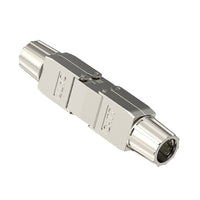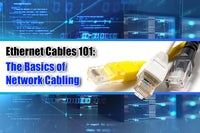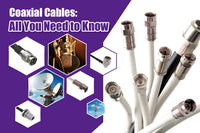In telecommunications, fiber optic cables, twisted pair cables, and coaxial cables are commonly known to people for their wide usage. But have you ever heard about “hybrid cable”? Do you know what it is? This special cable integrates multiple conductor types, optimizing their functions.
Let’s delve into the world of hybrid cables, explaining everything about hybrid cables, including their constructions, benefits, and applications.
What is Hybrid Cable?
Hybrid cables refer to a unique blend of various conductor types within a single cable jacket, including optical fiber and copper conductors. They are essential conduits used for both data and power transmission. Hybrid cables are widely used in surveillance systems, base stations, and other large-scale network deployments.
The construction of a hybrid cable can be more complex than a single fiber optic or copper cable, allowing the optical and electrical signals coexist together without interference especially in complex environments. Hybrid cables are available in different types, but most types are composed of optical fiber, copper, tight buffer, insulation layers, and an outer jacket.

So why are hybrid cables necessary in our daily lives? A single fiber optic or copper cable has its limitations. You know that copper cables feature great conductor electricity and can be used for Power over Ethernet (PoE) applications, but these cables can be susceptible to electromagnetic and radio frequency interference (EMI and RFI). This makes copper cables unsuitable for longer distance. Fiber optic cables made of optical fibers feature high speed, bandwidth, and longer transmission distances, but they lack the capability to support PoE. To ensure maximum performance of network equipment, cables between different points must supply power and transmit data simultaneously. That’s the reason hybrid cables have been developed.
Note: The term "hybrid cable" encompasses a unique construction featuring two distinct conductor types within a single cable jacket. In contrast, "hybrid fiber-coaxial" denotes the integration of two diverse cabling methods. In this setup, fiber optic cables connect the network to the node, while coaxial cables transmit the network signal to your home.
Advantages of Hybrid Cable
As mentioned above, hybrid cable integrates the transmission capabilities of optical fibers and twisted copper wires, allowing them to simultaneously carry data and electrical signals. The hybrid cable maximizes the pros of optical fibers and minimizes the cons of copper wires.
Twisted pair cables transmit data via copper wires, and the transmission quality is largely affected by the wire condition and cable length. These cables typically have a maximum running length of 100 meters (328 feet). However, hybrid cables, which contain optical fibers, can transmit data at a longer distance and higher bandwidth. Additionally, hybrid cables support Power over Ethernet (PoE) over longer distances, making them more suitable for various applications requiring data transmission and power supply.
A hybrid cable has many benefits, and we list three main advantages:
- Reduce the Number of Cables: Twisted pair and fiber optic cables are used in large-scale network installations, which require bulk cables. However, the construction of hybrid cables can reduce the number of cables. With hybrid cables, you can save a lot of warehouse space and long-term costs.
- PoE Support: Because of the existence of copper wires, hybrid cables can be used for PoE power supply. PoE allows you to connect network-related devices without any power outlet. It is known that fiber optic cables cannot support PoE, but things can be different with the introduction of hybrid cables. The hybrid cables can also reduce the data and power pathways. For example, the installation of a security camera can benefit from hybrid cables as you don’t need to worry about the distance.
- Remote Installation: Hybrid cables eliminate the need for local power sources to deliver power at individual locations. Instead, power is efficiently transmitted from a centralized remote source through the hybrid cables.
Composite vs. Hybrid Cable
The composite cable typically consists of multiple transmission mediums of the same material within a single cable, such as all-fiber or all-copper mediums. Hybrid cables differentiate themselves by transmission medium of different materials. For example, the hybrid cable commonly features a combination of copper conductors and optical fibers. This unique construction allows the cable to maximize the advantages of each material, offering enhanced performance in various applications.
Applications of Hybrid Cables
Hybrid cables are used to connect different points transmitting power, data, or communications. Hybrid cables can be used in a wide range of applications:
- 5G Network:Hybrid cables play a crucial role in 5G networks, enabling power and data transmission in the network infrastructure. These cables support high-speed data transfer and low-latency communication for 5G technology while delivering power to network components, such as small cells and antennas.
- Surveillance Systems:Surveillance systems have become increasingly popular in recent years. People tend to use copper cables for PoE functions to make the installation easier. Hybrid cables allow for the connection of cameras and control units over a long distance.
- Industrial Automation:Hybrid cables can also be used for sensors, actuators, and controllers in industrial settings, streamlining the processes and enhancing efficiency.
- Renewable Energy:These cables are employed in renewable energy systems such as solar and wind farms to transmit power.
For more information on this topic, you can keep up on our blogs. While VCELINK offers general and basic information for our customers and other visitors to the website, it’s not professional advice.




Be the first one to comment.
Leave a comment